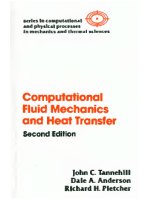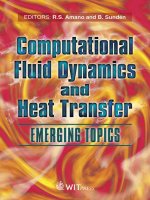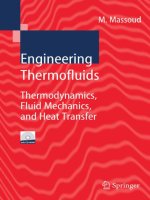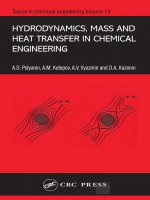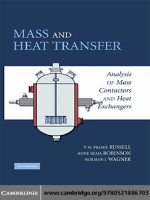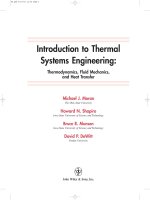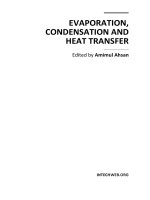engineering thermofluids thermodynamics fluid mechanics and heat transfer
Bạn đang xem bản rút gọn của tài liệu. Xem và tải ngay bản đầy đủ của tài liệu tại đây (20.74 MB, 1,132 trang )
Mahmoud Massoud
Engineering Thermofluids
Thermodynamics, Fluid Mechanics, and Heat Transfer
Mahmoud Massoud
Engineering Thermofluids
Thermodynamics, Fluid Mechanics, and Heat Transfer
With 345 Figures and 13 Tables
Dr. Mahmoud Massoud
University of Maryland
Department Mechanical Engineering
20742 College Park, MD
USA
Library of Congress Control Number: 2005924007
ISBN 10 3-540-22292-8 Springer Berlin Heidelberg New York
ISBN 13 978-3-540-22292-7 Springer Berlin Heidelberg New York
This work is subject to copyright. All rights are reserved, whether the whole or part of the material is
concerned, specifically the rights of translation, reprinting, reuse of illustrations, recitation, broadcasting,
reproduction on microfilm or in other ways, and storage in data banks. Duplication of this publication or
parts thereof is permitted only under the provisions of the German Copyright Law of September 9, 1965,
in its current version, and permission for use must always be obtained from Springer-Verlag. Violations are
liable to prosecution under German Copyright Law.
Springer is a part of Springer Science+Business Media
springeronline.com
© Springer-Verlag Berlin Heidelberg 2005
Printed in Germany
The use of general descriptive names, registered names, trademarks, etc. in this publication does not imply,
even in the absence of a specific statement, that such names are exempt from the relevant protective laws
and regulations and therefore free for general use.
Typesetting: PTP-Berlin Protago-T
E
X-Production GmbH, Germany
Final processing by PTP-Berlin Protago-T
E
X-Production GmbH, Germany
Cover-Design: Medionet AG, Berlin
Printed on acid-free paper 62/3141/Yu – 5 4 3 2 1 0
In loving memory of my dear father
Ghahreman Massoud
Preface
Thermofluids, while a relatively modern term, is applied to the well-established
field of thermal sciences, which is comprised of various intertwined disciplines.
Thus mass, momentum, and heat transfer constitute the fundamentals of ther-
mofluids. This book discusses thermofluids in the context of thermodynamics,
single- and two-phase flow, as well as heat transfer associated with single- and
two-phase flows. Traditionally, the field of thermal sciences is taught in universi-
ties by requiring students to study engineering thermodynamics, fluid mechanics,
and heat transfer, in that order. In graduate school, these topics are discussed at
more advanced levels. In recent years, however, there have been attempts to inte-
grate these topics through a unified approach. This approach makes sense as
thermal design of widely varied systems ranging from hair dryers to semiconduc-
tor chips to jet engines to nuclear power plants is based on the conservation equa-
tions of mass, momentum, angular momentum, energy, and the second law of
thermodynamics. While integrating these topics has recently gained popularity, it
is hardly a new approach. For example, Bird, Stewart, and Lightfoot in Transport
Phenomena, Rohsenow and Choi in Heat, Mass, and Momentum Transfer, El-
Wakil, in Nuclear Heat Transport, and Todreas and Kazimi in Nuclear Systems
have pursued a similar approach. These books, however, have been designed for
advanced graduate level courses. More recently, undergraduate books using an in-
tegral approach are appearing.
In this book, a wide range of thermal science topics has been brought under one
umbrella. This book is intended for graduate students in the fields of Chemical,
Industrial, Mechanical, and Nuclear Engineering. However, the topics are dis-
cussed in reasonable detail, so that, with omission of certain subjects, it can also
be used as a text for undergraduate students. The emphasis on the application as-
pects of thermofluids, supported with many practical examples, makes this book a
useful reference for practicing engineers in the above fields. No course prerequi-
sites, except basic engineering and math, are required; the text does not assume
any degree of familiarity with various topics, as all derivations are obtained from
basic engineering principles. The text provides examples in the design and opera-
tion of thermal systems and power production, applying various thermofluid dis-
ciplines. The goal is to give equal attention to a discussion of all power produc-
tion sources. However, as George Orwell would have put it, power production
from nuclear systems has been treated in this book “more equally”!
As important as the understanding of a physical phenomenon is for engineers,
equally important is the formulation and solution to the mathematical model rep-
resenting each phenomenon. Therefore, rather than providing the traditional
mathematical tidbits, a chapter is dedicated to the fundamentals of engineering
VIII Preface
mathematics. This allows each chapter to address the subject topic exclusively,
preventing the need for mathematical proofs in the midst of the discussion of the
engineering subject.
Topics are prepared in seven major chapters; Introduction, Thermodynamics,
Single-Phase Flow, Single-Phase Heat Transfer, Two-Phase Flow and Heat Trans-
fer, Applications of Thermofluids in Engineering, and the supplemental chapter on
Engineering Mathematics. These chapters are further broken down into several
subchapters. For example, Chapter II for Thermodynamics consists of Chapter IIa
for Fundamentals of Thermodynamics, Chapter IIb for Power Cycles, and Chap-
ter IIc for Mixtures of Non-Reactive Gases.
Each chapter opens by briefly describing the covered topic and defining the
pertinent terminology. This approach will familiarize the reader with the impor-
tant concepts and facilitate comprehension of topics discussed in the chapter. To
aid the understanding of more subtle topics, walkthrough examples are provided,
in both British and SI units. Questions at the end of each chapter remind the
reader of the key concepts discussed in the chapter. Homework problems, with
answers to some of the problems, are provided to assist comprehension of the re-
lated topic. Throughout this book, priority is given to obtaining analytical solu-
tions in closed form. Numerical solutions and empirical correlations are presented
as alternatives to the analytical solution, or when an analytical solution cannot be
found due to the complexities involved.
Multi-authored references are cited only by the name of the first author. When
an author is cited twice in the same chapter, the date of the publication follows the
author’s name.
A CD-ROM containing menu-driven engineering software (ToolKit) is pro-
vided for performing laborious tasks. In addition to ToolKit, the CD-ROM con-
tains folders named after the associated chapters. These folders contain the listings
of computer programs, sample input, and sample output files for various applica-
tions. The items that are included in the software are identified in the text.
The data required in various chapters are tabulated in Chapter VIII, Appendi-
ces. To distinguish the appendix tables from the tables used in various chapters,
the table numbers in the appendices are preceded by the letter A.
Acknowledgement
I am grateful to my contributors listed below, who kindly answered my questions,
provided useful comments and suggestions, or agreed to review several or all of
the chapters of this book:
– Professor Kazys Almenas
*
, University of Maryland
– Professor Morton Denn, City College of New York
– Dr. Thomas L. George, Numerical Applications, Inc.
– Mr. James Gilmer, Bechtel Power Corporation
– Professor Peter Griffith, MIT
– Dr. Gerard E. Gryczkowski, Constellation Energy
– Professor Yih Yun Hsu
*
, University of Maryland
– Dr. Ping Shieh Kao, Computer Associates, Inc.
– Professor Mujid S. Kazimi, MIT
– Professor John H. Lienhard IV, University of Houston
– Professor Anthony F. Mills, UCLA
– Professor Mohammad Modarres, University of Maryland
– Dr. Frederick J. Moody, General Electric and San Jose State University
– Professor Amir N. Nahavandi
*
, Columbia University
– Mr. Farzin Nouri, Bechtel Power Corporation
– Professor Karl O. Ott, Purdue University
– Dr. Daniel A. Prelewicz, Information System Laboratories, Inc.
– Professor Marvin L. Roush, University of Maryland
– Mr. Raymond E. Schneider, Westinghouse Electric Company
– Dr. Farrokh Seifaee, Framatome ANP, Inc.
– Mr. John Singleton, Constellation Energy
– Professor Neil E. Todreas, MIT
– Professor Gary Z. Watters, California State University at Chico
– Professor Frank M. White, University of Rhode Island
Technical assistance of Richard B. Mervine and Seth Spooner and editorial assis-
tance of Ruth Martin and Edmund Tyler are gratefully acknowledged. Thanks are
due my students at the University of Maryland, Martin Glaubman, Katrina Groth,
Adam Taff, Keith Tetter, and Wendy Wong for providing useful feedback and
suggestions. I also appreciate the efforts of my editors Gabriel Maas of Springer-
Verlag and Danny Lewis and colleagues of PTP-Berlin GmbH. I commend all the
contributors for assisting me in this endeavor and emphasize that any shortcoming
is entirely my own.
*
Retired
Table of Contents
*
I. Introduction 1
1. Definition of Thermofluids 1
2. Energy Sources and Conversion 2
3. Energy in Perspective 4
4. Power Producing Systems 5
5. Power Producing Systems, Fossil Power Plants 6
6. Power Producing Systems, Nuclear Power Plants 11
7. Power Producing Systems, Greenpower Plants 17
8. Comparison of Various Energy Sources 23
9. Thermofluid Analysis of Systems 25
Questions 27
Problems 28
II. Thermodynamics 31
IIa. Fundamentals 32
1. Definition of Terms 33
2. Equation of State for Ideal Gases 41
3. Equation of State for Water 46
4. Heat, Work, and Thermodynamic Processes 55
5. Conservation Equation of Mass for a Control Volume 64
6. The First Law of Thermodynamics 66
7. Applications of the First Law, Steady State 70
8. Applications of the First Law, Transient 81
9. The Second Law of Thermodynamics 96
10. Entropy and the Second Law of Thermodynamics 105
11. Exergy or Availability 116
Questions 123
Problems 125
IIb. Power Cycles 144
1. Gas Power Systems 144
2. Vapor Power Systems 161
3. Actual Versus Ideal Cycles 174
*
The related flow chart follows this section
XII Table of Contents
Questions 177
Problems 178
IIc. Mixtures 187
1. Mixture of Non-reactive Ideal Gases 187
2. Gases in Contact with Ice, Water, and Steam 193
3. Processes Involving Moist Air 196
4. Charging and Discharging Rigid Volumes 203
Questions 217
Problems 218
III. Fluid Mechanics 223
IIIa. Single-Phase Flow Fundamentals 224
1. Definition of Fluid Mechanic Terms 224
2. Fluid Kinematics 233
3. Conservation Equations 239
Questions 274
Problems 275
IIIb. Incompressible Viscous Flow 286
1. Steady Incompressible Viscous Flow 286
2. Steady Internal Incompressible Viscous Flow 289
3. Pressure Drop in Steady Internal Incompressible
Viscous Flow 295
4. Steady Incompressible Viscous Flow in Piping Systems 310
5. Steady Incompressible Viscous Flow Distribution
in Piping Networks 337
6. Unsteady Internal Incompressible Flow 343
7. Fundamentals of Waterhammer Transients 371
Questions 383
Problems 383
IIIc. Compressible Flow 399
1. Steady Internal Compressible Viscous Flow 399
2. The Phenomenon of Choked or Critical Flow 414
Questions 426
Problems 427
IV. Heat Transfer 431
IVa. Conduction 431
1. Definition of Heat Conduction Terms 432
2. The Heat Conduction Equation 437
3. Analytical Solution of Heat Conduction Equation 444
Table of Contents XIII
4. Lumped-Thermal Capacity Method
for Transient Heat Conduction 445
5. Analytical Solution of 1-D S-S Heat Conduction Equation,
Slab 448
6. Analytical Solution of 1-D S-S Heat Conduction Equation,
Cylinder 461
7. Analytical Solution of 1-D S-S Heat Conduction Equation,
Sphere 474
8. Analytical Solution of Heat Conduction Equation,
Extended Surfaces 477
9. Analytical Solution of Transient Heat Conduction 485
10. Numerical Solution of Heat Conduction Equation 499
Questions 501
Problems 502
IVb. Forced Convection 518
1. Definition of Forced Convection Terms 518
2. Analytical Solution 521
3. Empirical Relations 534
Questions 541
Problems 541
IVc. Free Convection 549
1. Definition of Free Convection Terms 549
2. Analytical Solution 550
3. Empirical Relations 553
Questions 557
Problems 558
IVd. Thermal Radiation 561
1. Definition of Thermal Radiation Terms 561
2. Ideal Surfaces 568
3. Real Surfaces 573
4. Gray Surfaces 578
5. Radiation Exchange Between Surfaces 579
Questions 592
Problems 592
V. Two-Phase Flow and Heat Transfer 601
Va. Two-Phase Flow Fundamentals 601
1. Definition of Two-Phase Flow Terms 601
2. Two-Phase Flow Relation 606
3. Two-Phase Critical Flow 622
Questions 632
Problems 632
XIV Table of Contents
Vb. Boiling 637
1. Definition of Boiling Heat Transfer Terms 637
2. Convective Boiling, Analytical Solutions 641
3. Convective Boiling, Experimental Observation 648
4. Pool Boiling Modes 650
5. Flow Boiling Modes 658
Questions 672
Problems 673
Vc. Condensation 677
1. Definition of Condensation Heat Transfer Terms 677
2. Analytical Solution 678
3. Empirical Solution 682
4. Condensation Degradation 684
Questions 685
Problems 686
VI. Applications 687
VIa. Heat Exchangers 687
1. Definition of Heat Exchanger Terms 687
2. Analytical Solution 690
3. Analysis of Shell and Tube Heat Exchanger 702
4. Analysis of Condensers 710
5. Analysis of Steam Generators 716
6. Transient Analysis of Concentric Heat Exchangers 719
Questions 723
Problems 723
VIb. Fundamentals of Flow Measurement 728
1. Definition of Flow Measurement Terms 728
2. Repeatability, Accuracy, and Uncertainty 729
3. Flowmeter Types 732
4. Flowmeter Installation 744
Questions 745
Problems 745
VIc. Fundamentals of Turbomachines 747
1. Definition of Turbomachine Terms 747
2. Centrifugal Pumps 749
3. Dimensionless Centrifugal Pumps Performance 755
4. System and Pump Characteristic Curves 762
5. Analysis of Hydraulic Turbines 769
6. Analysis of Turboject for Propulsion 777
Questions 779
Problems 780
Table of Contents XV
VId. Simulation of Thermofluid Systems 784
1. Definition of Terms 784
2. Mathematical Model for a PWR Loop 786
3. Simplified PWR Model 791
4. Mathematical Model for PWR Components, Pump 802
5. Mathematical Model for PWR Components, Pressurizer 811
6. Mathematical Model for PWR Components, Containment 819
7. Mathematical Model for PWR Components, Steam Generator 827
Questions 829
Problems 829
VIe. Nuclear Heat Generation 841
1. Definition of Some Nuclear Engineering Terms 841
2. Neutron Transport Equation 853
3. Determination of Neutron Flux in an Infinite Cylindrical Core 859
4. Reactor Thermal Design 877
5. Shutdown Power Production 882
Questions 884
Problems 884
VII. Engineering Mathematics 901
VIIa. Fundamentals 901
1. Definition of Terms 901
VIIb. Differential Equations 911
1. Famous Differential Equations 911
2. Analytical Solutions to Differential Equations 919
3. Pertinent Functions and Polynomials 936
VIIc. Vector Algebra 943
1. Definition of Terms 943
VIId. Linear Algebra 963
1. Definition of Terms 963
2. The Inverse of a Matrix 968
3. Set of Linear Equations 971
VIIe. Numerical Analysis 976
1. Definition of Terms 976
2. Numerical Solution of Ordinary Differential Equations 979
3. Numerical Solutions of Partial Differential Equations 985
4. The Newton–Raphson Method 1004
5. Curve Fitting to Experimental Data 1006
XVI Table of Contents
VIII. Appendices 1011
I. Unit Systems, Constants and Numbers 1013
II. Thermodynamic Data 1023
III. Pipe and Tube Data 1049
IV. Thermophysical Data 1059
V. Nuclear Properties of Elements 1091
References 1097
Index 1111
Table of Contents XVII
Contents
Introduction
Thermodynamics
Fluid Mechanics
Heat Transfer
Two-Phase Flow &
Heat Transfer
Mathematics
Fluid Mechanics (III)
Two-Phase Flow
Fundamentals
Incompressible
Viscous Flow
Compressible
Viscous Flow
Pressure Drop Critical Flow
Thermodynamics
(II)
Fundamentals Power Cycles Mixtures
Condensation
Applications (VI)
Heat
Exchangers
Flow
Measurement
Turbomachines
Simulation
of Systems
Nuclear Heat
Heat Transfer (IV)
Two-phase Heat
Transfer
Conduction Convection Radiation
Boiling
Engineering Mathematics (VII)
Fundamentals
Differential
Equations
Vector
Algenbra
Linear
Algebra
Numerical
Analysis
I
II
III
IV
V
VII
IIa IIb
IIc
IIIa IIIb IIIc
IVa IVb & IVc IVd
VIb VIc
VIa
VId
VIe
VIIa VIIb VIIc VIId VIIe
Applications
VI
Two-Phase Flow &
Heat Transfer (V)
Va Va Vb Vc
Note: Roman numerals refer to the related chapters
Nomenclature
In this book, for the sake of brevity and consistency, as few symbols as possible
are used. Thus, to minimize the number of symbols, yet clearly distinguish vari-
ous parameters, lower case and italic fonts have been used whenever a symbol
represents two or more parameters. For example, while V represents volume, v is
used for specific volume, V for velocity, v for kinematic viscosity, and
V
for
volumetric flow rate. To avoid confusion when solving problems by hand, the
reader may use
for volume.
Special attention must be paid whenever h representing specific enthalpy and h,
standing for heat transfer coefficient, appear in the same equation. This occurs in
chapters IVe and IVf, dealing with boiling and condensation. Also note that h and
H stand for height. Similarly, In Chapter Va, s represents an element of length as
well as entropy while S stands for slip ratio, respectively.
The units provided below in front of each symbol, are just examples of com-
monly used units. They do not preclude the representation of the same symbol
with different sets of units. The details of the SI units are discussed in Appendix I.
English
symbols Definition SI Unit British Unit
a Acceleration m/s
2
ft/s
2
a Radius m in
A Helmholtz function J Btu
A Area m
2
ft
2
b Width m ft
B Bulk modulus Pa psi
B Buckling cm
–2
in
–2
c Speed of sound m/s ft/s
c
p
Specific heat at constant pressure W/kgC Btu/lbm·F
c
v
Specific heat at constant volume W/kgC Btu/lbm·F
C
d
Discharge Coefficient – –
C
D
Drag coefficient – –
d, D Diameter m (cm) ft (in)
e Specific energy W/kg Btu/lbm
e Uncertainty – –
E Modulus of Elasticity Pa psi
E Total energy J Btu
E Total emissive power W Bu/s
English
XX Nomenclature
symbols Definition SI Unit British Unit
F Force N lbf
F View factor - -
F Peaking factor - -
g Gibbs function J Btu
g Gravitational acceleration m/s
2
ft/s
2
g
c
Conversion constant kgm/Ns
2
slug·ft/lbf·s
2
G Mass flux kg/sm
2
lbm/s·ft
2
G Irradiation W/m
2
Btu/s·ft
2
h Head m ft
ƫ Plank’s constant J·s Btu·s
h Heat transfer coefficient W/m
2
C Btu/h·ft
2
·F
h Specific enthalpy kJ/kg Btu/lbm
H Height m ft
H Enthalpy J Btu
I Geometric inertia m
-1
ft
-1
I Irreversibility J Btu
I Spectral intensity W/m
2
·
P
m·sr Btu/s·ft
2
·
P
m sr
j Conversion factor J/J ft·lbf/Btu
J Radiosity W/m
2
·
P
m -
J Superficial velocity m/s ft/s
J Neutron current density s
–1
cm
–2
s
–1
·ft
–2
J Bessel function of first kind – –
k
s
Spring constant – –
k Boltzmann constant J/K Btu/R
k Thermal conductivity W/mK Btu/h·ft·F
k
f
Infinite medium multiplication factor – –
k
eff
Finite medium multiplication factor – –
K Frictional loss coefficient – –
l Mean free path cm in
L Diffusion length cm in
m Mass kgm lbm
m
Mass flow rate kg/s lbm/s
M Molecular weight kg/kmol lb/lbmol
N
A
Avogadro number – –
P Pressure Pa psi
P Perimeter m ft
q Heat transfer per unit mass J/kg Btu/lbm
'q
Linear heat generation rate W/m kW/ft
q
cc
Heat flux W/m
2
Btu/h·ft
2
q
ccc
Volumetric heat generation rate W/m
3
Btu/h·ft
3
Q Heat transfer J Btu
Q
Rate of heat transfer W Btu/s
R Gas constant kPa·m
3
/kg·K ft·lbf/lbm·R
Nomenclature XXI
English
symbols Definition SI Unit British Unit
r, R Radius m (cm) ft (in)
R Thermal resistance C/W h·F/Btu
R
u
Universal gas constant kJ/kmol·K ft·lbf/lbmol·R
s Element of length m ft
s Tube or rod pitch cm in
s Specific entropy J/kg·K Btu/lbm·R
s Volumetric neutron source
strength cm
–3
·s
–1
in
–3
·s
–1
S Entropy J/K Btu/R
S Slip ratio – –
S Surface area m
2
ft
2
S
g
Specific gravity – –
t Time s s
T Temperature C (K) F (R)
T Torque m·N ft·lbf
u Specific internal energy J/kg Btu/lbm
u
Unit vector – –
U Internal energy J Btu
U Overall heat transfer coefficient W/m
2
·K Btu/h·ft
2
·F
v Kinematics viscosity m
2
/s ft
2
/h
v secific volume m
3
/kgm ft
3
/lbm
V Vlocity m/s ft/s
V Volume m
3
ft
3
V Voltage V V
V
Volumetric flow rate m
3
/s ft
3
/s
W Weight kg lbf
w Work per unit mass
of working fluid J/kg Btu/lbm
W Work J Btu
W
Power W Btu/s
x Thermodynamic quality – –
X Flow quality – –
y mole fraction – –
Y Gas expansion factor – –
Z Elevation m ft
Greek
symbols Definition SI Unit British Unit
D
Void fraction, Absorptivity – –
E
Volumetric thermal
expansion coeff. K
–1
R
–1
E
Volumetric flow ratio – –
J
Ratio of c
p
/c
v
– –
J
Shearing strain – –
XXII Nomenclature
Greek
symbols Definition SI Unit British Unit
G Boundary layer thickness mm in
' Difference in values – –
H
Emissivity – –
H Strain – –
6 Macroscopic cross section cm
–1
–
ȗ Effectiveness – –
K
Efficiency – –
K
Eta factor – –
T
Azimuthal angle – –
N
Boltzmann constant J/K Btu/R
N
Isothermal compressibility Pa
–1
psi
–1
N
Thermal conductivity (tensor) W/m· C Btu/h·ft·F
O
System thermal length m ft
O
Mean free path cm in
O
Wavelength
P
m –
P
Absorption coefficient cm
2
–
P
Dynamic viscosity N·s/m
2
bm/h·ft
Q
Number of fast neutrons
per fission – –
U
Density kg/m
3
lbm/ft
3
U
Reflectivity – –
V
Surface tension N/m lbf/ft
V
Tensile stress Pa psi
V
Stefan-Boltzmann constant W/m
2
·K
4
Btu/ft
2
·h·R
4
V
Microscopic cross section cm
–2
–
V
Measure of entropy production J/K Btu/R
W
Shear stress Pa psi
W
Transmissivity – –
I
Relative humidity – –
I
Flux s
–1
·cm
–2
s
–1
·ft
–2
I
Specific availability
(closed system) kJ/kg Btu/lbm
)
Availability (closed system) kJ Btu
)
Viscous Dissipation function W Btu/s
F
Fission spectrum of an isotope MeV
–1
Btu
–1
M
Zenith angel – –
\ Stream function – –
\
Specific availability
(control volume) kJ/kg Btu/lbm
<
Availability (control volume) kJ Btu
Z
Humidity ratio – –
Ȧ Impeller Speed of a turbomachine rad/s rad/s
: Solid angle sr –
Nomenclature XXIII
Subscripts
B body, buoyancy
CL Centerline
C.V. control volume
e equivalent or hydraulic diameter
f saturated liquid
f friction
f free stream, bulk
g saturated steam
h equivalent or hydraulic diameter
l local
r reduced
max maximum
min minimum
s surface, shaft
sat saturation
v vapor
Abbreviations
# numbers of
1-D one dimensional
Av Avogadro number
b Barns
C Celsius
cm centimeter
eV electron volt
E exponent (Example: 1 u 10
3
= 1E3)
ft foot, feet
F Fahrenheit
g gram
GPM gallon per minute
h hour
hp horsepower
in inch
J Joules
k Kilo
K Kelvin
ln natural logarithm, logarithm to the base e = 2.7182818
log logarithm to the base 10
m meter
min minute
XXIV Nomenclature
mm millimeter
MBtu million Btu
MeV Million electron volt
MWe Mega Watt electric
MWt Mega Watt thermal
R Rankine
s second
S-S steady state
W Watt
I
.
. Introduction
1. Definition of Thermofluids
The study of thermofluids integrates various disciplines of the field of thermal sci-
ences. This field consists of such topics as thermodynamics, fluid mechanics, and
heat transfer, all of which are discussed in various chapters of this book. The fas-
cinating concept of energy is the common denominator in all these topics. Al-
though we are intuitively familiar with energy through our various experiences it
is, nonetheless, difficult to formulate an exact definition. One might say energy is
the ability to do work, but then we must first define work. According to Huang we
may hypothesize that “energy is something that all matter has.” We leave the
definitions and discussion of energy, heat, work, and power to the chapter on
thermodynamics. In this chapter we introduce thermofluids and discuss the engi-
neering applications of thermofluids in the design and operation of thermal sys-
tems, such as those used in power production.
Thermal systems deal with the storage, conversion, and transportation of energy
in its many forms. These may include a jet engine that converts fuel energy to me-
chanical energy, an electric heater that converts electrical energy to heat energy, or
even a shotgun, which converts chemical energy to kinetic energy. Having defined
thermal systems, we now define fluids. In general, any substance that is not a solid
can be considered as a fluid. In this book the only fluids, we consider in the design
and operation of thermal systems are liquids and gases especially water and air, as
they are by far the most abundant fluids on earth. Liquids and gases in thermal sys-
tems are referred to as working fluids. As discussed in the chapter on fluid mechan-
ics, there are also other types of fluids such as blood, glue, lava, slurry, tar, and
toothpaste, which are analyzed differently than liquids and gases.
From this brief introduction, we conclude that: thermofluids is a subject that
analyzes systems and processes involved in energy, various forms of energy, and
transfer of energy in fluids. Since fluids generally come in contact with solids, in
this book we will include the study of energy transfer in both fluids and solids.
This book is prepared in seven chapters. In the present chapter, we discuss the
three sources of energy for power production and describe various power produc-
ing systems. This provides sufficient background to start Chapter II and learn
about thermodynamics and its associated laws governing the processes involved in
thermal systems. This is followed by Chapter III on fluid mechanics and its related
topics on the application of the working fluids in thermal systems. Chapter III
deals exclusively with the flow of single-phase fluids. The topic of heat transfer
in both solids and single-phase fluids is discussed in Chapter IV. Chapter V then
2 I. Introduction
discusses the mechanisms associated with two-phase flow. Chapter V also dis-
cusses heat transfer when a fluid changes phase such as the boiling of water and
condensation of steam. The knowledge gained in the first five chapters is then
used in Chapter VI to discuss the applications of thermofluids in the design and
operation of such thermal systems as heat exchangers (steam generators, feedwa-
ter heaters, and condensers), turbines, and pumps. Engineering mathematics cov-
ering a wide range of topics in advanced calculus is compiled in Chapter VII.
This allows us in each chapter to focus exclusively on the topic at hand and pre-
vents us from any need to discuss mathematics in these chapters.
2. Energy Source and Conversion
Energy is essential for most advances in society and the continuous improvement
of the quality of life. We use a variety of means to convert energy for industrial,
transportation, residential, and commercial applications.
From time to time, the world has experienced energy crises, defined as the
shortage of supply of energy or the environmental consequences associated with
the use of a source of energy. Such crises prove to be important reminders of how
vital energy is for transportation, commerce, industry, and residential use. These
crises also serve as the motivation to improve and broaden the application of en-
ergy sources and for the quests to find new sources of energy.
Figure I.2.1 shows the interaction between various forms of energy and the re-
spective means of energy conversion. Let’s examine this figure by first consider-
ing for instance, pumping water to a reservoir. The mechanical energy of the
pump is used to lift water, hence increasing water’s potential energy, and to fill the
reservoir. The reservoir then returns the stored energy in water in the form of ki-
netic energy when we open the faucet in our homes. The pump itself must be
powered by a prime mover such as an electric motor or an internal combustion en-
gine, indicating conversion of electrical or chemical energies to mechanical en-
ergy.
Stored
Energy
Mechanical
Energy
Electrical
Energy
H
y
d
r
a
u
l
i
c
P
u
m
p
H
y
d
r
a
u
l
i
c
T
u
r
b
i
n
e
Electric Generator
Electric
Motor
B
a
t
t
e
r
y
Ba
t
t
e
r
y
Ch
a
r
g
e
r
Figure I.2.1. Means of energy conversion (Marquand)
2. Energy Source and Conversion 3
If water instead of flowing in the faucet is used to power a hydraulic turbine,
the water kinetic energy would be converted back to mechanical energy. The me-
chanical energy in a generator is converted to electrical energy. The electrical en-
ergy may then be used to charge batteries, which then become the reservoir for
stored energy. In this energy conversion process, one form of stored energy is
converted to a new form of stored energy.
The converse is also possible when we use a battery to produce electrical en-
ergy, which can then be used in an electric motor to be converted to mechanical
energy. The motor, in turn would serve as the prime mover of a hydraulic pump
to fill a reservoir thus, converting the mechanical energy into stored energy.
Figure I.2.2 is a more comprehensive diagram of energy conversion including
various types of energy and the conversion pathways between various types. For
example, radiant, chemical, electrical, mechanical, and nuclear energies can be
converted to thermal energy while thermal energy can be converted to mechanical
and electrical energies.
Radiant
Energy
Nuclear
Energy
Chemical
Energy
Thermal
Energy
Mechanical
Energy
Electrical
Energy
Combustion chamber
C
h
e
m
i
c
a
l
l
u
m
i
n
e
s
c
n
c
e
Formation of
elements in star
Electric motor
Electric generator
F
r
i
c
t
i
o
n
F
i
s
s
i
o
n
&
F
u
s
i
o
n
R
e
a
c
t
o
r
s
E
v
a
p
o
r
a
t
i
o
n
S
o
l
a
r
s
t
e
a
m g
e
n
e
r
a
t
o
r
s
Laser
Solar cell
C
h
a
r
g
i
n
g
b
a
tte
r
y
D
i
s
h
a
r
g
i
n
g
b
a
t
t
e
r
y
T
h
e
r
m
o
e
le
c
t
r
ic
ity
B
o
d
y
m
u
s
c
l
e
s
Nuclear explosion
R
e
s
i
s
t
a
n
c
e
h
e
a
t
i
n
g
S
t
e
a
m
t
u
r
b
i
n
e
I
n
t
e
r
n
a
l
c
o
m
b
u
s
t
i
o
n
e
n
g
i
n
e
s
D
i
s
s
o
c
i
a
t
i
o
n
b
y
R
a
d
i
o
l
y
s
i
s
P
h
o
t
o
s
y
n
t
h
e
s
i
s
Figure I.2.2. Important forms of energy and the pathway for conversion (Marion)
The conversion of one type of energy to another takes place in what is known
as a process. Many of such processes including the direction of a process and
such concepts as efficiency are discussed in Chapter II. In the remainder of this
chapter, we discuss various sources of energy and briefly describe various types of
energy conversion system for power production.
4 I. Introduction
3. Energy in Perspective
The world’s energy resources must fulfill the needs of an increasing world popula-
tion. The world energy resources are generally divided into three categories, fossil
fuels, nuclear fuels, and green, renewable or alternative resources. Historically,
wood was the primary source of energy before the industrial revolution. The first
oil producing well was operational in 1859, which was followed by the introduc-
tion of the internal combustion engine (1876), the first steam-generated electric
plant (Edison, New York city 1882), the steam turbine (1884), and the Diesel En-
gine (1892). We now discuss two important types of fuels; fossil and nuclear.
3.1. Fossil Fuels
This category consists of coal, oil, and natural gas. Today, over 80% of the
world’s energy supply is from fossil fuels, of which 60% is from oil and gas and
the remaining 40% is from coal. Coal is pure carbon and natural gas is primarily
methane hence, both of these fuels can be used without substantial processing.
Petroleum, on the other hand, is found in the form of crude oil and must be refined
for various applications. In the United States, coal is primarily used for power
production and in industrial applications, while natural gas is used for industrial
and residential applications as well as in power production. Petroleum in the
United States is primarily used for transportation (54%) followed by industrial,
residential, and power generation.
3.2. Nuclear Fuels
According to Einstein’s equation E = mc
2
, the energy obtained from 1 kg of ura-
nium is equivalent to the burning of 3.4 thousand tons of coal
1
. Similarly from the
conversion of mass to energy, we find that the energy equivalent of mass in a bar-
rel of oil is over 2 billion times more than the energy obtained by its combustion.
The share of power production from nuclear energy has increased since 1950.
Nuclear energy is used primarily for power production, although nuclear reactors
are also used to power naval surface ships and submarines. Battery powered sub-
marines must surface periodically to recharge their batteries using diesel engines,
which require an intake of oxygen to support combustion. Since no combustion
occurs in a nuclear reactor to require oxygen, nuclear powered submarines can
remain submerged indefinitely. The world’s first nuclear-powered submarine was
commissioned in 1954 and the first commercial nuclear power plant (90 MWe)
became operational in Shippingport, Pennsylvania in 1957. The physical proc-
esses occurring in nuclear reactors can be classified as either fission or fusion.
1
The energy equivalent of 1 gram of mass is E = (1/1,000) kg × (300,000,000)
2
m
2
/s = 9E13 J =
8.53E10 Btu.

